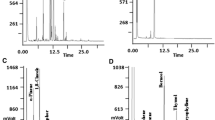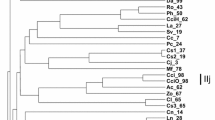Abstract
Bioactivity of essential oils (EOs) from Monarda species has never been investigated on phytoparasitic nematodes. In this study, the EOs from two Italian ecotypes of Monarda didyma and M. fistulosa and their main compounds, carvacrol, γ-terpinene, o-cymene, and thymol, were evaluated for their in vitro activity on the infective stages of phytoparasitic nematodes Meloidogyne incognita and Pratylenchus vulnus, as well as on M. incognita egg hatch. Soil treatments with the two EOs were also investigated for their suppressiveness on M. incognita on tomato. Both EOs were strongly active on M. incognita juveniles, as a only 1.0 μL mL−1 LC50 value was evaluated after a 24-h exposure to both EOs, whereas a lower activity was recorded on P. vulnus (15.7 and 12.5 μL mL−1 LC50 values for M. didyma and M. fistulosa EOs, respectively). Among the EOs’ main compounds, carvacrol was highly active also at a short exposure in low concentrations, whereas γ-terpinene and thymol were much less active on both nematode species and o-cymene showed a discrete activity on P. vulnus only at the highest concentration. Hatch percent of M. incognita eggs treated with M. didyma and M. fistulosa EOs was always significantly lower than in water or in Tween 20 and Oxamyl solutions. In the experiment in soil, the multiplication of M. incognita and gall formation on tomato roots was significantly reduced by soil treatments with both EOs. The strong nematicidal activity of both Monarda EOs may suggest them as potential sources of new sustainable nematicidal products.

Similar content being viewed by others
References
Adams RP (2007) Identification of essential oil components by gas chromatography/mass spectrometry, 4th edn. Allured Publishing Corporation, Carol Stream
Adebayo O, Bèlanger A, Khanizadeh S (2013) Variable inhibitory activities of essential oils of three Monarda species on the growth of Botrytis cinerea. Can J Plant Sci 93:987–995
Al-Banna L, Darwisj RM, Aburjai T (2003) Effect of plant extracts and essential oils on root-knot nematode. Phytopathol Mediterr 42:123–128
Andrés MF, Gonzáles-Coloma A, Sanz J, Burillo J, Sainz P (2013) Nematicidal of essential oils: a review. Phytochem Rev 11:371–390
Argentieri MP, D’Addabbo T, Tava A, Agostinelli A, Jurzysta M, Avato P (2008) Evaluation of nematicidal properties of saponins from Medicago ssp. Eur J Plant Pathol 120:189–197
Avato P, Morone-Fortunato I, Ruta C, D’Elia R (2005) Glandular hairs and essential oils in micropropagated plants of Salvia officinalis L. Plant Sci 169:29–36
Avato P, D’Addabbo T, Leonetti P, Argentieri MP (2013) Nematicidal potential of Brassicaceae. Phytochem Rev 12:791–802
Avato P, Laquale S, Argentieri MP, Lamiri A, Radicci V, D’Addabbo T (2017) Nematicidal activity of essential oils from aromatic plants of Morocco. J Pest Sci 90:711–722
Bakkali F, Averbeck S, Averbeck D, Idaomar M (2008) Biological effects of essential oils—a review. Food Chem Toxicol 46:446–475
Can Baser KH (2008) Biological and pharmacological activities of carvacrol and carvacrol bearing essential oils. Curr Pharm Des 14:3106–3119
Coolen WA (1979) Methods for the extraction of Meloidogyne spp. and other nematodes from roots and soil. In: Lamberti F, Taylor CE (eds) Root-knot nematodes (Meloidogyne species), systematics, biology and control. Academic Press, London, pp 317–329
D’Addabbo T, Carbonara T, Argentieri MP, Radicci V, Leonetti P, Villanova L, Avato P (2013) Nematicidal potential of Artemisia annua and its main metabolites. Eur J Plant Pathol 137:295–304
Davies KG, Curtis RHC (2011) Cuticle surface coat of plant–parasitic nematodes. Ann Rev Phytopathol 49:135–156
Duke JA (2002) Handbook of medicinal herbs, 2nd edn. CRC Press, Boca Raton
Echeverrigaray S, Zacaria J, Beltrão R (2010) Nematicidal activity of monoterpenoids against the root-knot nematode Meloidogyne incognita. Nematology 100:199–203
Faria Silva JM, Sena I, Ribeiro B, Rodrigues AM, Maleita Nobre CM, Abrantes I, Bennett R, Mota M, Figueiredo da Silva AC (2016) First report on Meloidogyne chitwoodi hatching inhibition activity of essential oils and essential oils fractions. J Pest Sci 89:207–217
Finney DJ (1978) Statistical method in biological assay, 3rd edn. Charles Griffin & Company Ltd, London, pp 39–68, 69–104
Fraternale D, Giamperi L, Bucchini A, Ricci D, Epifano F, Burini G, Curini M (2006) Chemical composition, antifungal and in vitro antioxidant properties of Monarda didyma L. essential oil. J Essent Oil Res 18:581–585
Gwinn KD, Greene SE, Trently DJ, Ownley BH (2006) Inhibition of sclerotia of Sclerotinia sclerotiorum by Monarda and its essential oils constituents (Abstr.). Phytopathology 96:S44
Gwinn KD, Greene SE, Ownley BH (2007) Monarda bioactive herbage reduces Rhizoctonia disease losses in tomato transplants (Abstr.). Phytopathology 97:S44
Gwinn KD, Ownley BH, Greene SE, Clark MM, Taylor CL, Springfield TN, Trently DJ, Green JF, Reed A, Hamilton SL (2010) Role of essential oils in control of Rhizoctonia damping-off in tomato with bioactive Monarda herbage. Phytopathology 100:493–501
Hussey RS, Barker KR (1973) A comparison of methods of collecting inocula of Meloidogyne spp. including a new technique. Plant Dis Rep 57:1025–1028
Ibrahim SK, Traboulsi AF, El-Haj S (2006) Effect of essential oils and plant extracts on hatching, migration and mortality of Meloidogyne incognita. Phytopathol Mediterr 45:238–246
Isman MB (2000) Plant essential oils for pest and disease management. Crop Prot 19:603–608
Isman MB, Miresmailli S, Machial C (2011) Commercial opportunities for pesticides based on plant EOs in agriculture, industry and consumer products. Phytochem Rev 10:197–204
Laquale S, Candido V, Avato P, Argentieri MP, D’Addabbo T (2015) Essential oils as soil biofumigants for the control of the root-knot nematode Meloidogyne incognita on tomato. Ann Appl Biol 167:217–224
Lewis WJ, Van Lenteren JC, Phatak SC, Tumlinson JH (1997) A total system approach to sustainable pest management. Proc Natl Acad Sci 94:12243–12248
Martín Á, Varona S, Navarrete A, Cocero MJ (2010) Encapsulation and co-precipitation processes with supercritical fluids: applications with essential oils. Open Chem Eng J 4:31–41
Mattarelli P, Epifano F, Minardi P, Di Vito M, Modesto M, Barbanti L, Bellardi MG (2017) Chemical composition and antimicrobial activity of essential oils from aerial parts of Monarda didyma and Monarda fistulosa cultivated in Italy. J Essent Oil Bear Plants 20:76–86
Mazza G, Chubey BB, Kiehn F (1987) Essential oil of Monarda fistulosa L. var. menthaefolia, a potential source of geraniol. J Flavour Fragr 2:129–132
Mazza G, Kiehn FA, Marshall HH (1993) Monarda: a source of geraniol, linalool, thymol and carvacrol-rich essential oils. In: Janick J, Simon JE (eds) New crops. Wiley, New York, pp 628–631
Moody EH, Lownsbery BF, Ahmed JM (1973) Culture of the root-lesion nematode Pratylenchus vulnus on carrot disks. J Nematol 5:225–226
Ntalli N, Menkissoglu-Spiroudi U (2011) Pesticides of botanical origin: a promising tool in plant protection. In: Stoytecheva M (ed) Pesticides: formulations, effects, fate. INTECH Open Access Publisher, pp 3–24
Ntalli N, Ferrari F, Giannakou I, Menkissoglu-Spiroudi U (2010) Phytochemistry and nematicidal activity of the essential oils from 8 Greek Lamiaceae aromatic plants and 13 terpene components. J Agric Food Chem 58:7856–7863
Ntalli NG, Nasiou E, Menkissoglu-Spiroudi U (2013) Evaluation of essential oils from rosemary, orange, lavandula and false yellowhead on hatching and motility of root-knot nematode. J Agric Sci Technol A 3:603–616
Oka Y (2001) Nematicidal activity of essential oil components against the root-knot nematode Meloidogyne javanica. Nematology 3:159–164
Oka Y, Nacar S, Putievsky E, Ravid U, Yaniv Z, Spiegel Y (2000) Nematicidal activity of essential oils and their components against the root-knot nematode. Phytopathology 90:710–715
Perry RN, Moens M (2011) Introduction to plant parasitic nematodes; modes of parasitism. In: Jones J, Gheysen G, Fenoll C (eds) Genomics and molecular genetics of plant-nematode interactions. Springer, Dordrecht, pp 3–20
Pinochet J, Verdejo S, Marull J (1991) Host suitability of eight Prunus spp. and one Pyrus communis rootstocks to Pratylenchus vulnus, P. neglectus and P. thornei. J Nematol 23:570–575
Ricci D, Epifano F, Fraternale D (2017) The essential oil of Monarda didyma L. (Lamiaceae) exerts phytotoxic activity in vitro against various weed seeds. Molecules 22:222
Ruark SJ, Shew BB (2010) Evaluation of microbial, botanical, and organic treatments for control of peanut seedling diseases. Plant Dis 94:445–454
Santana O, Andrés MF, Sanz J, Errahmani N, Lamiri A, González-Coloma A (2014) Valorization of essential oils from Moroccan aromatic plants. Nat Prod Commun 9:1109–1114
Tabanca N, Bernier UR, Ali A, Wang M, Demirci B, Blythe EK, Khan SI, Baser KHC, Khan IA (2013) Bioassay-guided investigation of two Monarda essential oils as repellents of yellow fever mosquito Aedes aegypti. J Agric Food Chem 61:8573–8580
Taylor AL, Sasser JN (1978) Biology, identification and control of root-knot nematodes (Meloidogyne spp.). North Carolina State University Graphics, Raleigh
Tsao R, Yu Q (2000) Nematicidal activity of monoterpenoid compounds against economically important nematodes in agriculture. J Essen Oil Res 12:350–354
Wesemael WML, Viaene N, Moens M (2010) Root-knot nematodes (Meloidogyne spp.) in Europe. Nematology 13:3–16
Yeats GW, Bongers T, De Goede RGM, Freckman DW, Georgieva SS (1993) Feeding habits in soil nematode families and genera—an outline for soil ecologists. J Nematol 25:315–331
Zotti M, Colaianna M, Morgese MG, Tucci P, Schiavone S, Avato P, Trabace L (2013) Carvacrol: from ancient flavoring to neuromodulatory agent. Molecules 18:6161–6172
Author information
Authors and Affiliations
Corresponding author
Ethics declarations
Conflict of interest
The authors declare that they have no conflict of interest.
Ethical approval
This article does not contain any studies with human participants or animals performed by any of the authors.
Additional information
Communicated by M. B. Isman.
Rights and permissions
About this article
Cite this article
Laquale, S., Avato, P., Argentieri, M.P. et al. Nematotoxic activity of essential oils from Monarda species. J Pest Sci 91, 1115–1125 (2018). https://doi.org/10.1007/s10340-018-0957-1
Received:
Revised:
Accepted:
Published:
Issue Date:
DOI: https://doi.org/10.1007/s10340-018-0957-1




